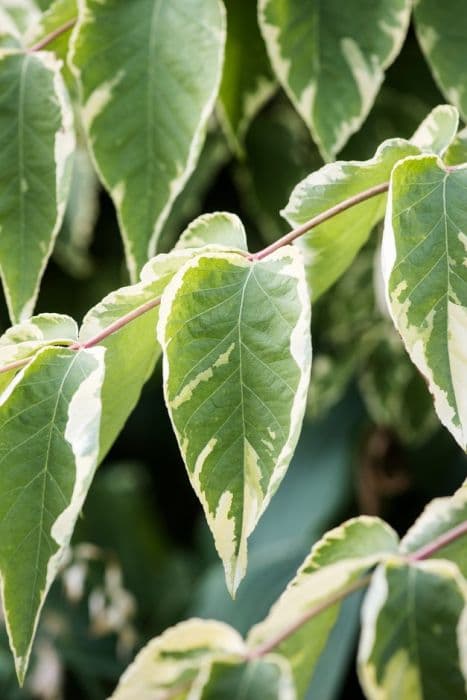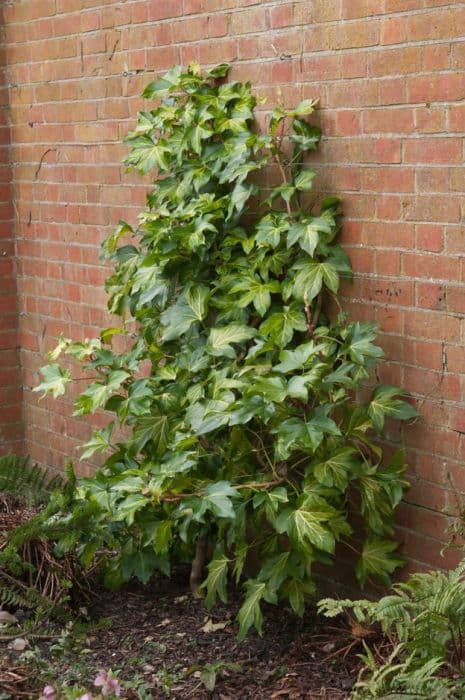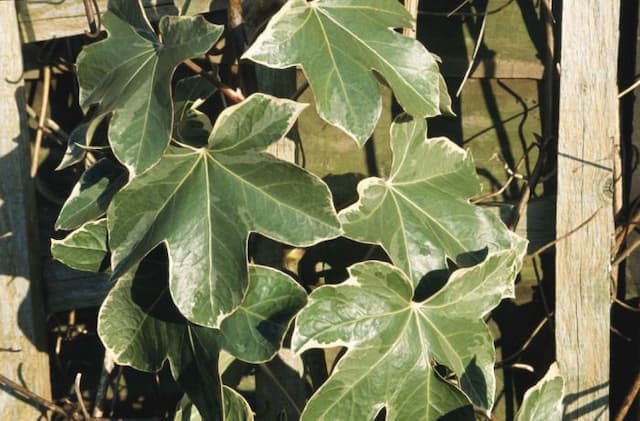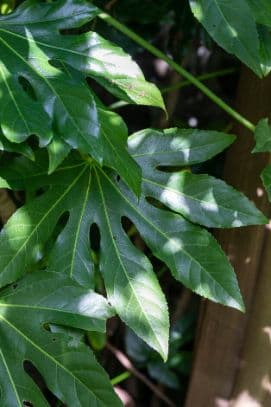English Ivy Hedera helix 'Ice Cream' (v)

ABOUT
The 'Ice Cream' variety of English ivy is a visually attractive plant known for its unique foliage. The leaves are variegated with a mix of green and creamy white colors, giving the plant an eye-catching appeal. Each leaf is usually shaped with several lobes, often three to five, with a pointed tip. The variegation pattern on the leaves can vary, with some leaves having a creamy center and green edges, while others may have green streaks or mottling against the white background. The contrast between the green and white gives the 'Ice Cream' ivy a refreshing and cool appearance, similar to its namesake. The leaves of this ivy have a glossy texture, which reflects light and adds a luminous quality to the plant's overall look. The plant's growth habit is trailing or climbing, typical of English ivy, and it is often used as a decorative element in indoor spaces, where its cascades of varied foliage can adorn shelves, mantels, or hanging baskets. Its ability to adapt to various light conditions adds to its versatility as a decorative houseplant. Over time and with proper care, it can develop a lush, dense appearance, further enhancing its beauty.
About this plant
 Names
NamesFamily
Araliaceae.
Synonyms
English Ivy, Common Ivy, European Ivy.
Common names
Hedera helix 'Ice Cream'
 Toxicity
ToxicityTo humans
English Ivy, including the 'Ice Cream' variety, is toxic to humans if ingested. The symptoms of poisoning may include abdominal pain, vomiting, and diarrhea. In some cases, contact with the skin can lead to dermatitis. The most serious risk arises from ingesting the berries, which can potentially cause sedation or hyperactivity in children.
To pets
English Ivy, specifically the 'Ice Cream' cultivar, is also toxic to pets. Ingesting the leaves or berries can lead to symptoms such as vomiting, abdominal pain, hypersalivation, and diarrhea in animals like dogs and cats. In severe cases, ingesting English Ivy may lead to more significant issues such as breathing difficulties, paralysis, coma, or even death, especially in small pets.
 Characteristics
CharacteristicsLife cycle
Perennials
Foliage type
Evergreen
Color of leaves
Variegated
Height
6-9 feet (1.8-2.7 meters)
Spread
3-6 feet (0.9-1.8 meters)
Plant type
Climber
Hardiness zones
5-9
Native area
Europe
Benefits
 General Benefits
General Benefits- Aesthetic Appeal: The variegated leaves of the Hedera helix 'Ice Cream', commonly known as English ivy, bring visual interest and beauty to garden spaces or indoor settings.
- Low Maintenance: English ivy is known for being hardy and requires minimal care once established, making it suitable for busy gardeners or those new to plant care.
- Versatile Growth: English ivy can grow in a variety of conditions, tolerating both full sun and full shade, which allows for flexible placement in the landscape or home.
- Ground Cover: Its dense growth habit makes it an excellent ground cover, helping to suppress weeds and reduce soil erosion in the garden.
- Climbing and Trailing: English ivy can climb walls and trellises or trail from hanging baskets, offering various uses in landscape and interior design.
- Habitat Support: It provides shelter and sometimes food for wildlife like birds and insects, contributing to the biodiversity of the area.
- Seasonal Interest: In outdoor settings, English ivy provides year-round greenery, with some varieties offering seasonal color changes.
 Medical Properties
Medical Properties- This plant is not used for medical purposes.
 Air-purifying Qualities
Air-purifying QualitiesThis plant is not specifically known for air purifying qualities.
 Other Uses
Other Uses- Hedera helix 'Ice Cream' (v), commonly known as English ivy, can be used in topiaries for its ability to climb and create intricate visual interest in garden designs.
- Crafting natural dyes from the leaves of the English ivy can provide a range of green tints to textiles, ideal for artisanal or homemade projects.
- The dense mat of English ivy can be used as a living mulch to help retain soil moisture and prevent weed growth in garden beds.
- As a natural insulator, English ivy can help keep buildings cooler by shading walls during the summer months when grown as a climbing vine.
- English ivy can be planted over unsightly structures like utility boxes or old stumps in the garden to provide a more aesthetically pleasing view.
- This plant's ability to adhere to surfaces can be used for creating green façades or "living walls," enhancing the visual appeal of exterior walls.
- English ivy can be shaped into green festive decorations for holiday events, offering a sustainable alternative to artificial garlands.
- Photographers can use English ivy as a lush backdrop for portrait photography, benefitting from its deep green leaves and texture.
- The plant can be trained to grow in decorative patterns along fences or trellises, offering a creative approach to garden design and privacy screening.
- Florists might use English ivy stems in floral arrangements or bouquets to add fullness and cascading greenery.
Interesting Facts
 Feng Shui
Feng ShuiThe English Ivy is not used in Feng Shui practice.
 Zodiac Sign Compitability
Zodiac Sign CompitabilityThe English Ivy is not used in astrology practice.
 Plant Symbolism
Plant Symbolism- Connection: As English Ivy is known to cling and climb over structures and trees, it symbolizes strong connections and friendships, representing the idea of sticking together through various conditions.
- Fidelity: Its evergreen nature and the ability to remain attached to surfaces symbolize faithfulness and eternal loyalty, making it common in wedding ceremonies in certain cultures.
- Eternal life: English Ivy stays green year-round, which is often associated with immortality and the eternal aspect of the human soul.
- Protection: English Ivy is thought to offer protection due to its dense growth, and it's sometimes used in traditions to ward off evil spirits or to bring safety to a home.
- Resilience: The plant's capability to survive in various conditions contributes to its symbolism as a representation of strength and the ability to recover from adversity.
- Memory and remembrance: Due to its lasting presence and perennial nature, it can be a symbol for memory and the importance of remembering loved ones and past experiences.
 Water
WaterEnglish Ivy 'Ice Cream' prefers to be watered when the top inch of soil feels dry to the touch, which is typically about once a week, but this can vary depending on environmental conditions. It's important to water thoroughly, allowing water to run out of the drainage holes at the bottom of the container. Approximately one to two gallons of water should be enough to saturate the soil. Make sure to reduce watering in the winter months when plant growth naturally slows down.
 Light
LightEnglish Ivy 'Ice Cream' thrives in bright, indirect light but can also adapt to low-light conditions. It's best to place it near a north- or east-facing window where it will receive gentle sunlight. Direct afternoon sun can scorch the leaves, so if you only have a south or west-facing window, use sheer curtains to diffuse the light.
 Temperature
TemperatureEnglish Ivy 'Ice Cream' performs well in a temperature range between 50°F and 70°F, making it suitable for most indoor environments. The plant can survive temporarily in temperatures as low as 30°F and as high as 80°F, but these are not ideal for long-term growth. The ideal conditions are a stable environment without sudden temperature changes.
 Pruning
PruningPrune English Ivy 'Ice Cream' to maintain its shape, encourage bushier growth, and remove any damaged or diseased foliage. The best time to prune is in the spring or summer when the plant is actively growing. Trimming the plant every few months will help keep it tidy and promote new growth.
 Cleaning
CleaningAs needed
 Soil
SoilEnglish Ivy 'Ice Cream' prefers well-draining soil with a blend of potting soil, peat, and perlite. It thrives at a pH range of 5.5 to 6.5, slightly acidic.
 Repotting
RepottingEnglish Ivy 'Ice Cream' should be repotted every two years to encourage growth and prevent it from becoming root-bound.
 Humidity & Misting
Humidity & MistingEnglish Ivy 'Ice Cream' flourishes best in moderate to high humidity levels, ideally between 40% to 60%.
 Suitable locations
Suitable locationsIndoor
Place in bright, indirect light and keep soil moist.
Outdoor
Needs partial shade, well-draining soil, shelter from extreme cold.
Hardiness zone
5-11 USDA
 Life cycle
Life cycleCommonly known as English ivy 'Ice Cream,' Hedera helix 'Ice Cream' begins its life as a seed, typically dispersed by birds. Upon germination, the seedling slowly develops into a juvenile form with lobed leaves and a climbing habit, anchoring itself with aerial rootlets. As it matures, it can transition into an adult stage where the leaves usually become less lobed and more ovate; flowering can occur, producing small, inconspicuous flowers, which upon pollination develop into berry-like fruits. These fruits are then eaten and dispersed by birds, completing the reproductive cycle. In its adult form, English ivy can also form dense ground covers if left to sprawl, and can survive for many years, often outliving the structures they climb on. English ivy is perennial, so its vegetative structures persist year after year, even if parts of the plant die back seasonally.
 Propogation
PropogationPropogation time
Spring-Early Summer
Propogation: English Ivy 'Ice Cream' is often propagated through stem cuttings, a method that is most successful during the spring and summer months when the plant is actively growing. To propagate through stem cuttings, a healthy section of stem about 4 to 6 inches long is selected and cut just below a node, where leaves attach to the stem. This cutting should have several leaves and can be dipped in a rooting hormone to encourage root development. The lower leaves are removed, and the cut end is planted in a mixture of peat and perlite kept moist but not waterlogged. It is important to maintain high humidity around the cutting, which can be achieved by covering the pot with a plastic bag or placing it in a propagation chamber. In a few weeks, the cutting should develop roots and can be transferred to a normal growing medium. Care should be taken to ensure that the cutting does not dry out during the rooting process.









